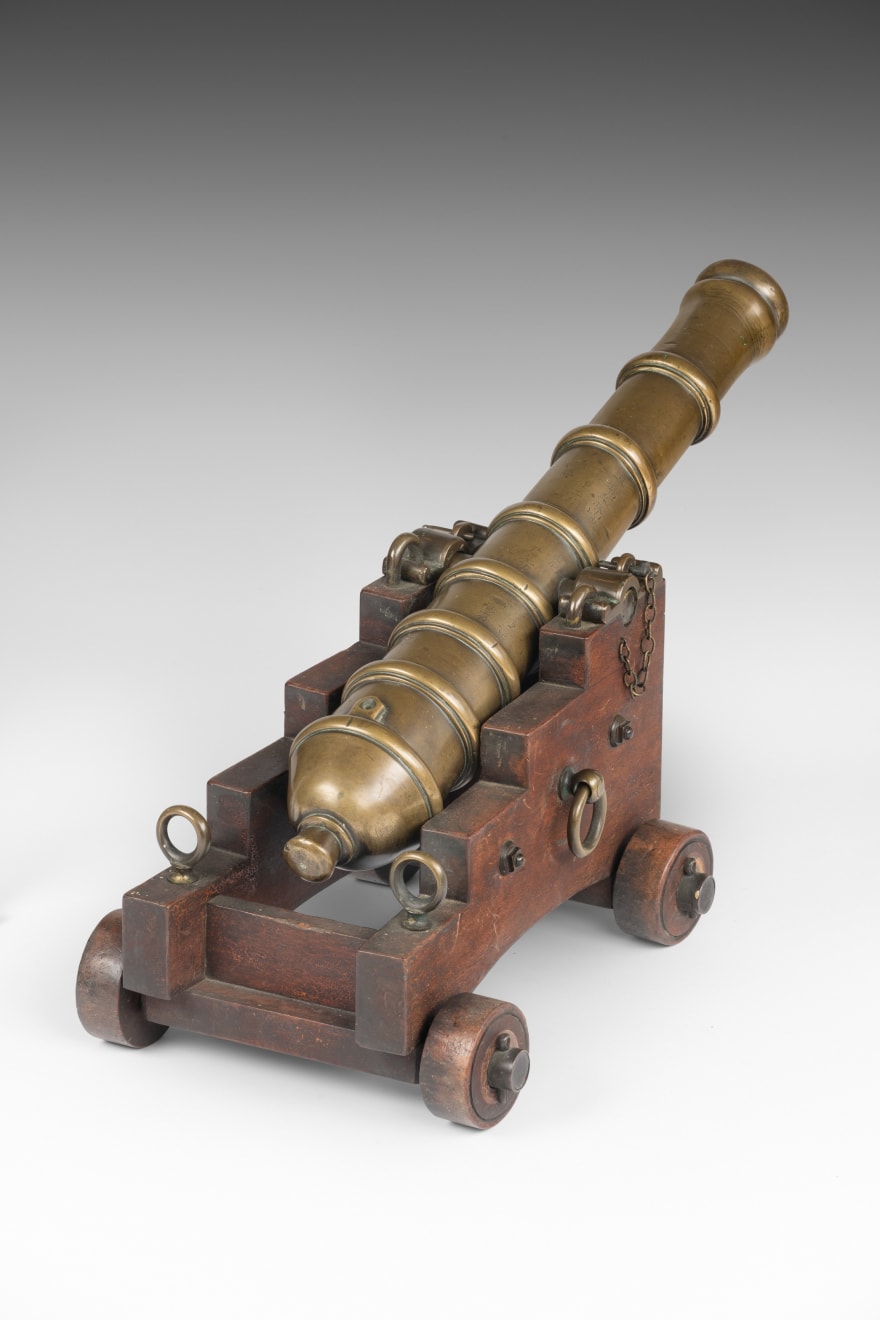Chinese Bronze Cannon
CHINA, QING DYNASTY, DATED 1853
The barrel 63.5cm overall
7161
Further images
Provenance
Commissioned by the Governor-General of Zhili Province.Private Collection, UK.
Comprising a turned barrel with six reinforcing rings, engraved with inscriptions to three of the sections, with a forward-facing trunnion, bulbous muzzle, the tapered breech with small swollen knob or...
Comprising a turned barrel with six reinforcing rings, engraved with inscriptions to three of the sections, with a forward-facing trunnion, bulbous muzzle, the tapered breech with small swollen knob or cascabel, on a stepped wooden carriage mounted with brass rings and raised on four wheels. The inscriptions translate as ‘Cannon No. 129 in the “Heaven" series. Weighing 30 jin. Cast in 1853 (3rd year of Xianfeng reign). Commissioned by the Governor-General of Zhili Province. Manufactured under supervision of a government arsenal. Its merit is thus revealed.’
The Qing military was influenced by both indigenous Chinese traditions and Western military technologies, which had been introduced via Jesuit missionaries and traders since the Ming Dynasty. The multi-ringed barrel and flared muzzle of this piece shows the influence of European artillery design. The date of manufacture of the cannon was from the height of the Taiping Rebellion (1850–1864), when the Qing court was urgently producing and deploying arms.
The inscriptions are typical of Qing dynasty artillery pieces, where cannon were labelled with their series, number, and weight. The inscriptions translate as follows:
天字第壹百二十九號
"Heaven series No. 129"
This refers to a serial number, with "Heaven" (天) being part of a classification system (common in Qing dynasty artillery, where Heaven, Earth, etc. categorized different batches). Cannons were often grouped and categorized using classical cosmological characters, indicating this was the 129th cannon in that batch.
鑄造
"Cast" or "Manufactured", which suggests this was a bronze or iron cast piece, made in an official foundry. Such foundries were usually state operated under the Board of Works and located in places like Beijing, Nanjing, or provincial arsenals.
三十斤
"30 jin" - A unit of weight (approximately 15 kilograms or 33 pounds).
勁炮
"Strong cannon" or "Powerful cannon"
直隸總督部
Office of the Governor-General of Zhili (Zhili Province).
Zhili (直隸) was a province in the Qing dynasty, broadly corresponding to modern-day Hebei and parts of Beijing and Tianjin. This indicates the cannon was commissioned under the jurisdiction of the Governor-General of Zhili, a very high-ranking official.
大清咸豐三年
Third year of the Xianfeng reign of the Great Qing (1853).
The reign of the Xianfeng Emperor began in 1851.
一造監
Supervised by the First Arsenal.
Likely refers to a particular production facility or arsenal division responsible for casting this piece.
乃見功
Thus, its merit is revealed.
This phrase indicates successful craftsmanship or military utility.
We are grateful to Christopher Coles for his research on this cannon.
The Qing military was influenced by both indigenous Chinese traditions and Western military technologies, which had been introduced via Jesuit missionaries and traders since the Ming Dynasty. The multi-ringed barrel and flared muzzle of this piece shows the influence of European artillery design. The date of manufacture of the cannon was from the height of the Taiping Rebellion (1850–1864), when the Qing court was urgently producing and deploying arms.
The inscriptions are typical of Qing dynasty artillery pieces, where cannon were labelled with their series, number, and weight. The inscriptions translate as follows:
天字第壹百二十九號
"Heaven series No. 129"
This refers to a serial number, with "Heaven" (天) being part of a classification system (common in Qing dynasty artillery, where Heaven, Earth, etc. categorized different batches). Cannons were often grouped and categorized using classical cosmological characters, indicating this was the 129th cannon in that batch.
鑄造
"Cast" or "Manufactured", which suggests this was a bronze or iron cast piece, made in an official foundry. Such foundries were usually state operated under the Board of Works and located in places like Beijing, Nanjing, or provincial arsenals.
三十斤
"30 jin" - A unit of weight (approximately 15 kilograms or 33 pounds).
勁炮
"Strong cannon" or "Powerful cannon"
直隸總督部
Office of the Governor-General of Zhili (Zhili Province).
Zhili (直隸) was a province in the Qing dynasty, broadly corresponding to modern-day Hebei and parts of Beijing and Tianjin. This indicates the cannon was commissioned under the jurisdiction of the Governor-General of Zhili, a very high-ranking official.
大清咸豐三年
Third year of the Xianfeng reign of the Great Qing (1853).
The reign of the Xianfeng Emperor began in 1851.
一造監
Supervised by the First Arsenal.
Likely refers to a particular production facility or arsenal division responsible for casting this piece.
乃見功
Thus, its merit is revealed.
This phrase indicates successful craftsmanship or military utility.
We are grateful to Christopher Coles for his research on this cannon.










